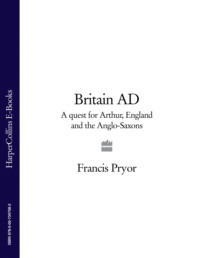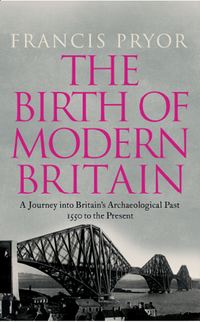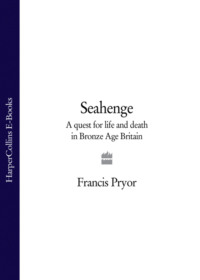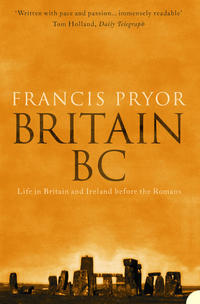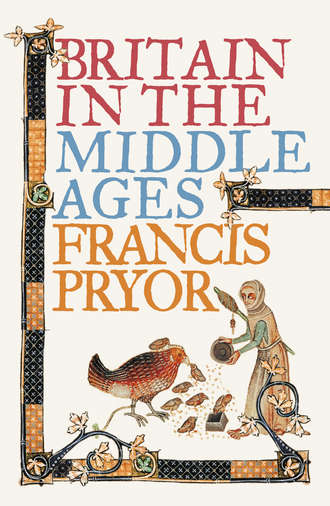
Полная версия
Britain in the Middle Ages: An Archaeological History
These are the reasons why I have decided that this book will depart from the usual convention of dismissing Saxon Britain in a chapter, before devoting the rest of the text to the high Middle Ages. Instead I have divided the medieval period into two Parts (I and II) of four and five centuries each. Part I will mainly be about Britons, Scots, Saxons and Vikings; Part II will be about aspects of town and country in the Middle Ages which are separated from the Saxon period by the Norman Conquest of 1066. I have attempted to be fair in the way I have apportioned chapters. But when it came to writing the book I was forcibly struck by the fact that there was far more interesting new material emerging about the pre-Norman, or Saxon, periods than about the Middle Ages. Furthermore, as much of this new work is taking place in southern Britain the book will, I am sorry to say, be biased towards the south and east in its geographical coverage. I regret this, but as I shall reiterate from time to time, this is not a textbook. I want it to reflect the way ideas are changing. The new information about Later Saxon England is having a profound effect on the way we view what happened later. So it cannot be ignored. As a result, the first four chapters are slightly longer than the following four.
While I was writing I became increasingly aware that the archaeology of buildings was a major new field in its own right. Today it involves detailed drawings, but also techniques of remote sensing that range from digital photography to enhanced forms of computer-aided design. I would very much have liked to discuss this in the pages that follow, and I must confess that I tried to put something on paper, but sadly none of it worked. I simply lacked the necessary hands-on experience to write with any conviction. So rather than fake it, I decided to leave it out.
Another important development has been the study of medieval woodworking and carpentry. I was introduced to this subject by my wife Maisie Taylor, who had begun to research the development of Bronze Age carpentry joints we encountered at Flag Fen. So she invited the leading expert on medieval carpentry, Cecil Hewitt, to come and see them. At the time he was recovering from a stroke, but even with slightly impaired speech he managed to give us one of the most exciting and rewarding days of our professional lives. Cecil’s excitement knew no limits, and was instantly transferred to both of us. The great man made us both look at our Bronze Age timbers through fresh eyes. What I didn’t know then was that Hewitt’s work was just one aspect of a rapidly growing new field of study which I will briefly touch on in Chapter 7.
I acquired an enormous respect for medieval archaeologists when I was a student in the mid-1960s. In fact I nearly forsook the True Path of prehistory to follow them. One of my teachers at Cambridge was Brian Hope-Taylor, who today is rightly regarded as an extraordinarily innovative pioneer. We all liked Brian. He was down to earth and never gave himself airs or graces. He was also a perfectionist, and refused to compromise on quality. His reports were beautifully illustrated, because earlier in his life he had been a professional artist and illustrator. He was particularly famous for the cover he had drawn for the Ordnance Survey Map of Britain in the Iron Age (sadly out of print).
While I was a student Brian was in the final throes of writing his most famous work, a huge report on his excavations at Yeavering, in Northumberland. Yeavering, or Ad Gefrin, to give it its Saxon name, was an Anglo-British palace complex beside a major pre-Roman hillfort, known as Yeavering Bell. The area was also stiff with prehistoric remains, which was why I was sitting at Brian’s feet. I had no intention of staying for more than the first lecture of his course, because then he would start on the post-Roman material. In the event I attended the entire course, and I even bought his great report shortly after it appeared in print in 1977, for the then huge sum of £33.5 It is still one of the most treasured books in my library. At the time Brian was one of a small group of medieval archaeologists who believed in ‘open area’ excavation. This was a new style of excavation that has now become commonplace: it involves the exposing of huge areas of land to get a clear impression of the totality of a site.
Brian didn’t just expose single buildings. Instead he looked at the spaces between and around the various structures, and in the process was able to build up a picture of a developing royal centre. His excavations took place over several seasons, mainly between 1953 and 1962, and seemed to touch on all aspects of life, from graves to humble dwellings, halls both great and small, and even a huge timber grandstand-like theatre. This was a vision of the seventh century AD that I desperately wanted to paint for earlier periods. It was quite simply inspiring, and it fundamentally affected my own style of archaeology.
Brian was a pioneer in the developing study of (in his case early) medieval archaeology. Medieval archaeology is still a very young discipline. The national learned society devoted to the subject, the Society for Medieval Archaeology, was founded in 1957, four years into the Yeavering project. This can be compared, for example, with my own field, where the Prehistoric Society came into being in 1935, as a development from the earlier Prehistoric Society of East Anglia (1908–35). There are many reasons for this relatively late academic acceptance of subjects like medieval and post-medieval archaeology (1967). In part one can blame simple academic snobbery along the lines of: ‘If it’s earlier it’s got to be better and more important.’ I also once detected (thankfully I think it has largely vanished) an attitude to these more recent subjects, among certain colleagues, which implied that the archaeology of recent times is somehow easier to do, and makes fewer intellectual demands on its practitioners. Nothing, but nothing, could be further from the truth.
But I must return to my own early exposure to medieval archaeology. Like every archaeological student in Britain, I had heard of the Wharram Percy deserted medieval village project in Yorkshire. The project was one of the longest-running research programmes in England (1950–90), and reports on various aspects of the work are still appearing in print. The results from Wharram continue to surprise. For example, recent work by Dr Simon Mays on the bones from the village churchyard has produced some unexpected results: babies were breast-fed until they were eighteen months old.6 During this period they thrived, but then began to fall behind when compared to modern infants. Comparisons between the rural population at Wharram and the nearby city of York show that although life in the country was generally healthier, women in the city did less demanding physical work. The urban population was exposed to a greater risk of infection, which also resulted in greater disease resistance. The rural population did not escape all the urban ailments. One would expect them to suffer from the ‘bovine’ form of tuberculosis, which they would have caught from animals, whereas they were actually infected by the ‘human’ form, which they probably contracted from regular visits to York, where the disease was relatively common. Only four of the 687 skeletons from Wharram showed signs of violent death, which was in stark contrast with the smaller Fishergate cemetery in York, where no fewer than nineteen people – mostly men – had met untimely ends.
Simon Mays’ work shows vividly how archaeology can illuminate history. What documents could possibly have differentiated between the two forms of tuberculosis and thereby have told us something new about town – country relations in the Middle Ages? Wharram Percy has been a most remarkable project, and I will return to it in some detail later, but medieval archaeology is now such a diverse subject that we cannot confine our attention to field projects, such as Wharram, alone. In these respects I think medieval and post-medieval archaeologists are facing considerable challenges of synthesis and comprehension. It would be so easy to lose oneself in detail. But somehow the best of them, people like Professor Richard Hodges at the University of East Anglia, can cope with the mountain of information and make it tell a fascinating story.
I’m aware that terms like ‘mountain of information’ are emotive and do not actually tell us very much, but in truth that ‘mountain’ has been produced by a quantum leap in archaeological activity. In this instance it is almost impossible to avoid superlatives, because the changes brought about by better advice to local planning authorities have transformed the way archaeology is practised in Britain. I will try to explain what has happened, and I apologise in advance for the acronyms, which are as unavoidable as the hyperbole.
In 1989 government in Whitehall issued a document called Planning Policy Guidance No. 16, known universally in archaeology as PPG-16. Despite its dreary title, PPG-16 has revolutionised the way archaeologists work – and think. PPG-16 established the principle that the ‘polluter pays’. In other words, if a developer is going to make a huge profit from building houses on top of, say, a deserted medieval village, he must first pay to have the site properly excavated and recorded. If a discovery made in the commercial excavation warrants it, he must also be prepared to accommodate what the archaeologists have revealed – perhaps in a museum or beneath an open space within the housing estate.
PPG-16 has now ‘bedded in’, and similar schemes exist across Europe. Many archaeologists have reservations about the competitive tendering that takes place between contracting archaeological companies for the big development contracts, but at least something is being done, and something is much better than wholesale destruction. Some of the discoveries have been spectacular. In Britain BC I described at least three PPG-16 commercial projects (in Cambridgeshire, Oxfordshire and the Thames Valley), and in Britain AD I could not possibly have ignored the astounding Anglo-Saxon ‘royal’ grave at Prittlewell on the outskirts of Southend. All of these sites were found by commercial excavations in advance of development schemes such as new roads, gravel quarries and housing estates. To give some idea of the scale of modern commercial archaeology, the total spend on British archaeology in the years just before the introduction of PPG-16 was in the order of £3–4 million. In 2004 it was £40–50 million.
This more than tenfold increase in excavation has brought with it a huge number of finds. There are millions and millions of them. Museum stores have ceased to cope, and many contractors are leasing warehouses, or simply dump what they cannot store after a few years. As someone who occasionally looks at prehistoric flint and pottery produced from commercial projects, I always find it much harder to persuade a contractor to take the finds back when I’ve done with them than I do to get them delivered in the first place.
A modern excavation, if it’s properly undertaken, will produce a representative sample of the range of pottery types, for example, that were being used on the site. So a small Anglo-Saxon farm would produce a relatively restricted range of kitchen and household wares, whereas finds from a major trading site would also include household vessels, plus finer table wares and a few exotic traded items. Assuming that the pottery found on the site does indeed represent what was being used in the past, the range and origin of the finds will tell us much about the status, tastes and preferences of the people who lived there. Although at first glance one might suppose that pottery can tell us less about life in the past than coins, which usually have known mints, dates and values, the statistical analysis of pottery (which computers now allow us routinely to perform) is having a huge effect on our understanding of the Middle Saxon period. We will see shortly that this was the first time since the Roman period that pottery began to be produced and distributed on an industrial scale. Richard Hodges considers this period to have been the first industrial revolution.
The huge increase in commercial archaeology has brought with it problems. New data is being produced daily,* but nobody is in a position to grapple with what it all means. As a result it simply remains dead data, and never makes that all-important step to become something of interest, which one might label ‘information’. A digest of the raw data is included in reports that archaeological contractors produce for their clients and which are housed in the various Sites and Monuments Records (SMRs) of the counties and self-governing cities of Britain. These client-reports form what is known in archaeology as the ‘grey literature’. Unlike ‘proper’ reports, submitted to established journals or monograph series, they are not peer-reviewed, and sometimes – I put it as mildly as I can – they are not very good. The good ones, usually of large-scale projects, can be excellent, but even the worst sometimes contain the basic information that someone who understands what he or she is doing can subsequently extract.
The basic information contained in the ‘grey literature’ reports is extracted to the records in the SMR, which today is computerised and linked to a map-based Geographical Information System, or GIS. Again I apologise for the sleep-inducing acronyms, but I shall use them all together just once: the combination of new data from PPG-16 projects, combined with the rapidly growing picture of ancient settlement patterns revealed by GIS in the county SMRs, has made it vastly simpler to place individual sites in their landscape contexts. And this has had a crucially important influence on the way we now think about early towns and the hinterland around them. At last, as we will shortly discover, our analyses of past landscapes can truly be considered ‘joined up’.
Many country Sites and Monuments Records also include information taken from aerial photography. This is a field which grew by leaps and bounds in the later twentieth century. In the best county SMRs the information on air photos is accurately transposed straight into the GIS, using sophisticated computer rectification software. Most air photos are not taken by flying directly above the site or landscape being surveyed. If the pictures are taken from an oblique angle, which may be necessary if slight humps and bumps on the ground are to show up in low sunlight, the images must be ‘rectified’ – i.e. straightened out – before they can be traced onto a map. Hence the need for the clever software.
The results of these processes can be little short of astonishing. Again I make no apologies for the language, because there really has been an information ‘explosion’ in aerial archaeology and its sister sub-discipline, Remote Sensing. Remote Sensing is a way of mapping ancient landscapes from the air, using radar and other techniques aside from photography. It’s still relatively young, but is already producing exciting results. Conventional aerial photography, on the other hand, is probably in its heyday.
Aerial photography has had a profound effect on archaeology since its first widespread use as a tool of reconnaissance during the Great War. In lowland England years and years of ploughing have removed most of the humps and bumps from the actual surface of the ground, but long-vanished features such as trackways, field ditches, even house foundations, can be seen as dark marks in growing crops. In a dry year, and only in a dry year, the roots of growing crops such as wheat and barley need to dive deep to find moisture. Directly above buried and long-filled-in ditches, wells or rubbish pits, the roots find dampness and the crops grow thick, lush and luxuriant. This darker growth, known as a cropmark, shows up clearly from the air.
The summer of 1976 was one of the driest on record, and it produced fabulous cropmarks. Subsequently we have had about a dozen good years for aerial photography, and much of this new material is slowly finding its way into local SMRs and the three National Monuments Records.7 It would seem that global warming does have a few beneficial side-effects. Cropmarks are particularly important in rural areas that have been subjected to intensive arable agriculture. They reveal the remains of farms, fields, roadways and settlements, some of which may already have been destroyed by farming and only survive as differences in soil texture. After some practice one can begin to ‘read’ a map of cropmarks and separate Bronze Age barrows and livestock fields from Iron Age farms and arable fields; one can also follow the extent of early medieval fields and the development of the ridge-and-furrow fields that have been so seriously denuded in the last two decades of the twentieth century. It is fair to say that this book could not have been written without the new information provided by commercial archaeology and aerial photography. It has affected not just the quantity of what we now know about the past, but its quality too. By learning more about them, modern archaeologists have gained huge respect for the humanity and achievements of the people they are privileged to study.
If my correspondence is anything to go by, there is a growing interest amongst the public at large in ‘real’ history and archaeology. A recent piece in the authoritative popular journal BBC History Magazine suggests that teachers are being told by their pupils that they have too much of Hitler and the twentieth century, and want to learn more medieval history.8 If their elders fail to grasp the point, brighter younger people now realise that the roots of the modern world lie in the Middle Ages. It is a period which demands reassessment from the bottom up: for too long it has been viewed from the perspective of the Normans, the Plantagenets and the Wars of the Roses. Certainly these were important dynasties and political events, but they were no more crucial to the development of the modern world than were the activities of millions of anonymous builders, merchants, farmers, mariners and miners. These people, and the inspired artists, architects and managers who supervised their work, were the true ancestors of today’s Britain.
Walk beneath the magnificent lantern above the transept of Ely Cathedral atop its ‘island’ of drier ground in the East Anglian Fens. Look up into the soaring space at the eight massive shaped oak trees that appear like so many distant gilded matchsticks, and you will be convinced that this is a modern building in every sense of the word. It was built by modern people who just happened to be living in an age of faith. Does that make them fundamentally different from us? I think not.
Religion and piety are foreign to many in the increasingly secular West. Speaking personally, I find the power exerted by religion over rational people quite inexplicable. But that simply reflects the fact that I do not believe in God. Today many people in Britain share my views, or rather lack of them, but my atheism does not make me somehow more modern than a person who has faith. Besides, faith and religion were never exclusively confined to the Middle Ages. The works of that great eighteenth-century genius J.S. Bach are suffused with faith. In Victorian times Charles Darwin encountered fierce public opposition, led by the Church of England, when he published On the Origin of Species in 1859. Even today, biblical creation and ‘directed evolution’ or ‘intelligent design’ are increasingly hot topics of debate. Many people in numerous countries across the modern world are perfectly content to live their lives within social and political contexts that are structured around faith. A strong belief in the power of God and the Church does not place the medieval world somehow outside our own times.
But to return to Ely, I find the achievements of those medieval master craftsmen still speak directly to me in a way that surpasses simple reason and logic. The construction of that soaring octagon high above the transept, apart from being one of the greatest achievements of medieval carpentry, required modern technical expertise, combined with modern thought and vision. I just cannot see the people with the minds to imagine, build, rebuild, maintain and support Ely as being significantly different from us today. I am aware, of course, that I am reading too much into one building, but it was the octagon at Ely that set me thinking. So I have reason to be thankful for that afternoon in the Fens. I looked upwards at the right time and in the right place. It was that single transporting moment that provided me with the motivation to write this book. Now it is time to start the story.
PART I On Britons, Saxons and Vikings (650–1066)

FIG 1 Principal places mentioned in Part I.
CHAPTER ONE The North/South Divide of the Middle Saxon Period
THIS CHAPTER will mainly be about the emergence of England. First, however, I must say a few words about the state of the countryside in general in the three centuries or so after the departure of the last Roman troops in AD 410, the generally accepted date for the end of the Roman presence in Britain. To summarise briefly, in the years prior to about 1960 it was believed that the British countryside reverted to a state of near wilderness when everything collapsed after the Roman withdrawal. The term often used to describe the situation was a ‘waste’ or ‘wasteland’, in which forests covered the land and the sun was excluded from the ground. Then waves of new settlers from across the North Sea arrived in Britain, felled the forests and pushed the few inadequate natives west towards Wales. The new people brought with them an entirely new way of life.
In Britain AD I discussed how archaeology and environmental science have shown that there was in fact very little forest regeneration, and that if anything the post-Roman landscape became more open, and the styles of farming more diverse. All the evidence points to continuity in the landscape: there was no wholesale disruption, such as one might expect if the entire population of what was shortly to become south and east England had in fact changed. Most towns and cities were indeed abandoned, but this was a process that had begun long before, in a remarkably sudden and coordinated fashion shortly after AD 300 – a full century prior to the Roman departure. The distinguished scholar of Roman Britain Richard Reece has suggested that this was because towns in Roman Britain were an idea ahead of their time, and that their grip on the population was at best tenuous – and soon slipped. Whatever the explanation, and I find Reece very convincing, Romano-British town life effectively ceased in the early fourth century and there was a (consequent?) rise in rural prosperity, which included the construction or enlargement of many elaborate country houses, known to everyone today as Roman villas.
To the north and far west the British population at large was less affected by the Roman presence, and many aspects of Iron Age life continued right through to post-Roman times. This is not to say that rural settlements here were grubby hovels, because the pre-Roman inhabitants of these areas had developed their own ways of living in what was sometimes quite a wet and windy environment. As we will see when we look at life in the Bernician royal centre at Yeavering in Northumberland, these people were perfectly capable of achieving a remarkably sophisticated style of life.
Plague may have played a role in keeping the population of Britain down in Early Saxon times. Bede mentions it on several occasions with reference to the seventh century.1 The problem I have with this is that the seventh century was a time when town life in Britain was pretty much non-existent, and it was in the crowded towns of the fourteenth century that the Black Death reaped its most devastating harvest. It affected rural areas too, but not as much. As we will see when we come to discuss that particular outbreak, plague tends to recur again and again, and it seems odd to me that it should die out at more or less the precise time that towns, in the form of the Middle Saxon wics, begin to come into their own.


